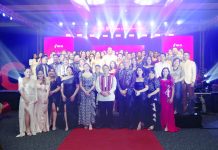[av_one_full first min_height=” vertical_alignment=” space=” custom_margin=” margin=’0px’ padding=’0px’ border=” border_color=” radius=’0px’ background_color=” src=” background_position=’top left’ background_repeat=’no-repeat’ animation=”]
[av_heading heading=’Reticulations: Patadyong as visual art ‘ tag=’h3′ style=’blockquote modern-quote’ size=” subheading_active=’subheading_below’ subheading_size=’15’ padding=’10’ color=” custom_font=”]
By Martin Genodepa
[/av_heading]
[av_textblock size=” font_color=” color=”]
THE artistry of the patadyong cannot be denied. That the early Spanish conquistadors who came to the country noticed this garb of the Visayans living in the lowlands could possibly be attributed to the colors of the fabric. While obviously bereft of the Islamic inspirations woven into Muslim costumes, the colors of the patadyong can be as dazzling as the malong’s. The flatness and seeming simplicity of the plaid and checkered patterns that characterize the textile are not inferiorities or shortcomings – they could be signifiers of the horizontality of the terrain and the angular geometric apportionment of the agricultural plains the lowlanders of the Visayas are familiar with. The patterns, upon examination, are nothing but macroscopic or enlarged multihued renditions of netting or gridding that is employed in weaving textiles or baskets or mats. Nets, it must be remembered, are universally indispensable equipment in fishing engagements especially of lowlanders who live in littoral regions. This process of amplification or of drawing attention to something, whether secreted or obscure, is an artistic function. The ability to make do with whatever fiber threads and colors are available to come up with an aesthetically pleasing and functional product is also a mark of ingenuity. In short, the patadyong is about lived experiences and living conditions manifesting in garment or clothing.
Not all patadyongs, however, are equal. The ones chosen for the exhibition Reticulations: Patadyong as
Visual Art, currently at the UP Visayas Art Gallery in Iloilo City, are from the past century – some no more recent than the 1970s. It might be safe to say that the period could very well be the decade when most patadyong-wearing rural folk from Iloilo, born in the later part of the 19th century, were dying out. Hence there has been no real or genuine demand for it since then except for use in folk dances and for souvenir by sentimental tourist, local and foreign.
The demand for patadyong and the current exoticization of it led to commercial production that subjugates individual expression. The personal use of color and re-invention of patterns that are within the domain and expertise of the mostly self-taught weavers of the past are usually left out; and contrived additions to the original patadyong make the recently-made ones artsy and kitschy. Adorno’s and Horkheimer’s ideas on genuine style and artificial style are instructive here. Genuine style emanates from the need to express oneself, one’s truth. Artificial style is the ghastly child of the culture industry. Art, whether folk or fine, requires uniqueness or an introduction of something that emanates distinctively from its creator. The dilemma of the current patadyong is also entangled in these ideas.
Color as visual art element has been explored and exploited especially by artists beginning in late1800s – the impressionist use of color, the personal use of color, and the scientific use of color. Americans Joseph Albers and Mark Rothko and Filipinos Constancio Bernardo and Lee Aguinaldo are some of the noted artists who have extensively employed colors overlapping with other colors in their canvases. Shapes represented by patterns, especially angled geometric ones like squares and rectangles, were used by Piet Mondrian and Victor Vasarely to create art that reflected spirituality and reveal mystical energy or aspired towards the analytic and rational. While the patadyong may never have the commercial or market value of fine art, its affinity to the visual arts cannot be dismissed mindlessly. One can gaze intently at the patadyong and lose oneself, in pure bliss or in rational contemplation perhaps, in the myriad of colors and endless grids. Experiencing the patadyong as visual art may be not much differently as when one looks absorbedly at a Rothko, a Mondrian, or an Aguinaldo.
Abroad, many abstractionists are creating paintings that takeoff from striped or checked fabrics akin to the patadyong. In the Philippines, despite its indigenousness, the patadyong rarely inspires artists who work in nonrepresentational art, Visayans included. But for Benji Belgica (1950-2013), the patadyong is artistic eureka!
Although with Ilonggo roots, Belgica grew up in Manila and attended Ateneo. He resided and began a family in Iloilo in the 1980s and was a member of Hubon Madiaas, an artist group which was very active in the 1980s. Belgica was skillful in making terracotta sculpture of humans with mouths agape, but his paintings, until the very end, were inspired by the overlapping of colors and patterns in the patadyong. Through his paintings and prints that are included in Reticulations, one can discern a true artist. Despite being largely unrecognized, Belgica, true to himself and his vision, doggedly stuck to his muse./PN
Reticulations: Patadyong as Visual Art which features patadyongs and artworks by Benji Belgica from the UPV Center for West Visayan Studies and private collections will run until Nov. 11.
[/av_textblock]
[/av_one_full]



